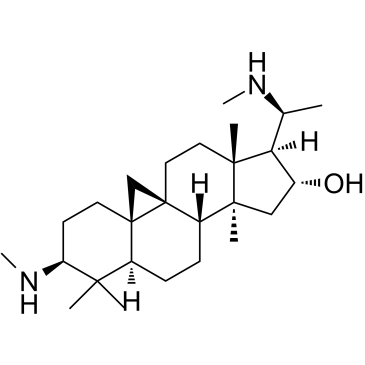Cyclovirobuxine
Modify Date: 2024-01-03 18:12:19

Cyclovirobuxine structure
|
Common Name | Cyclovirobuxine | ||
|---|---|---|---|---|
| CAS Number | 860-79-7 | Molecular Weight | 402.656 | |
| Density | 1.1±0.1 g/cm3 | Boiling Point | 495.7±10.0 °C at 760 mmHg | |
| Molecular Formula | C26H46N2O | Melting Point | N/A | |
| MSDS | N/A | Flash Point | 34.1±9.6 °C | |
Use of CyclovirobuxineCyclovirobuxine D (CVB-D) is the main active component of the traditional Chinese medicine Buxus microphylla. Cyclovirobuxine D induces autophagy and attenuates the phosphorylation of Akt and mTOR[1]. Cyclovirobuxine D inhibits cell proliferation of gastric cancer cells through suppression of cell cycle progression and inducement of mitochondria-mediated apoptosis[2]. Cyclovirobuxine D is beneficial for heart failure induced by myocardial infarction[3]. |
| Name | Cyclovirobuxin D |
|---|---|
| Synonym | More Synonyms |
| Description | Cyclovirobuxine D (CVB-D) is the main active component of the traditional Chinese medicine Buxus microphylla. Cyclovirobuxine D induces autophagy and attenuates the phosphorylation of Akt and mTOR[1]. Cyclovirobuxine D inhibits cell proliferation of gastric cancer cells through suppression of cell cycle progression and inducement of mitochondria-mediated apoptosis[2]. Cyclovirobuxine D is beneficial for heart failure induced by myocardial infarction[3]. |
|---|---|
| Related Catalog | |
| In Vitro | Cyclovirobuxine D (0-240 µM ;24-72 hours) shows a concentration- and time-dependent reduced cell viability after CVB-D treatment, only 10% MGC-803 cells and 20% MKN28 cells are alive at 72 h after treatment with 240 µM[2]. Cyclovirobuxine D (0-120 µM; 48 hours) arrests the cell cycle of gastric cancer cells at S phase in a concentration-dependent manner[2]. Cyclovirobuxine D (0-120 µM; 48 hours) leads to apoptosis in gastric cancer cells in a concentration-dependent manner, especially early stage apoptosis.Cyclovirobuxine D (0-120 µM; 48 hours) causes apoptosis via up-regulation of the apoptosis- related proteins, cleaved Caspase-3 and ratio of Bax/Bcl-2, in gastric cancer cells[2]. Cell Viability Assay[2] Cell Line: MGC-803 and MKN28 cells Concentration: 0, 30, 60, 120 and 240 µM Incubation Time: 24, 48, 72 hours Result: Reduced Cell Viability and Colony Formation Ability of Gastric Cancer Cells Cell Cycle Analysis[2] Cell Line: MGC-803 and MKN28 cells Concentration: 0, 30, 60, and 120 µM Incubation Time: 48 hours Result: Arrested cell cycle progressions of MGC-803 and MKN28 cells. Apoptosis Analysis[2] Cell Line: MGC-803 and MKN28 cells Concentration: 0, 30, 60, and 120 µM Incubation Time: 48 hours Result: Induced apoptosis of MGC-803 and MKN28 cells. Western Blot Analysis[2] Cell Line: MGC-803 and MKN28 cells Concentration: 0, 30, 60, and 120 µM Incubation Time: 48 hours Result: Up-regulated cleaved Caspase-3 and Bax and decreased the expression of Bcl-2 expression. |
| References |
| Density | 1.1±0.1 g/cm3 |
|---|---|
| Boiling Point | 495.7±10.0 °C at 760 mmHg |
| Molecular Formula | C26H46N2O |
| Molecular Weight | 402.656 |
| Flash Point | 34.1±9.6 °C |
| Exact Mass | 402.361023 |
| PSA | 44.29000 |
| LogP | 4.86 |
| Vapour Pressure | 0.0±2.9 mmHg at 25°C |
| Index of Refraction | 1.551 |
| Storage condition | 2-8C |
CHEMICAL IDENTIFICATION
HEALTH HAZARD DATAACUTE TOXICITY DATA
|
| MFCD00468040 |
| 9,19-Cyclopregnan-16-ol, 4,4,14-trimethyl-3,20-bis(methylamino)-, (3β,5α,9β,16α,20S)- |
| bebuxine |
| cyclovirobuxind |
| cyclovirobuxinum D |
| cyclobuxine D |
| (3β,5α,9β,16α,20S)-4,4,14-Trimethyl-3,20-bis(methylamino)-9,19-cyclopregnan-16-ol |
| cvb-d |
| Cyclovirobuxine-D |
| CYCLOVIROBUXINE |

